Clinician Task Force Publishes Guide to Telehealth
New paper discusses a range of topics, from preparing for a successful visit to determining whether telehealth is a good option for individual clients.
- By Laurie Watanabe
- Feb 24, 2021
 The Clinician Task Force (CTF) has published a guide to help seating and wheeled mobility professionals who want to use telehealth technology to work with certain Complex Rehab Technology (CRT) clients.
The Clinician Task Force (CTF) has published a guide to help seating and wheeled mobility professionals who want to use telehealth technology to work with certain Complex Rehab Technology (CRT) clients.
“The Clinician’s Guide to Use of Telehealth for CRT Service Provision” recognizes telehealth’s quantum leap in 2020, as the COVID-19 pandemic sharply restricted the ability of seating and mobility clinicians, suppliers, and consumers to meet face to face. Hospitals, clinics, skilled nursing facilities and assisted living centers turned visitors away to try to slow the virus’ spread, but an unintended side effect was the disruption of the assistive technology provision process.
While telehealth had been used by clinicians prior to the pandemic, the 2020 public health emergency accelerated its use and acceptance as a valuable alternative when face-to-face meetings aren’t possible.
Cathy Carver, PT, ATP/SMS, was the CTF’s Executive Director in 2020.
“The early impact of COVID-19 hindered access to clinics, therapists, and suppliers who provide CRT,” Carver says in the new document’s introduction. “However, with the approval of telehealth services for physical therapists (PTs) and occupational therapists (OTs), access improved. Many lessons were learned about the positive outcomes that can be obtained through the proper use of telehealth services in the provision of CRT. These positive outcomes underscore the need for federal and state policy makers to take action to make permanent the availability of telehealth from PTs and OTs on a national basis.”
The document begins with a “Considerations” section, which discusses how a seating team can prepare for a telehealth visit. Factors include determining who on the team will be appearing remotely versus in person; the experience and skill levels of each team member; which HIPAA-compliant telehealth platforms will be used; creating a backup plan to use if audio or visual communications fail during the meeting; confirming compliance with state licensure laws for OTs and PTs; and confirming that family members or caregivers are available to assist during the visit.
The document then discusses Personal Protective Equipment to be used during telehealth visits; the need for a referral prior to a telehealth visit; assessing the client’s seating and mobility needs; making equipment recommendations and selections; documentation, including why telehealth was chosen for the visit; fitting, training and delivery; clinical follow-up; and outcome measurements.
The document also includes case examples of instances in which telehealth was chosen and successfully used, and one example of why telehealth was considered, but ultimately was not used to work with an adult client with cerebral palsy.
Concluding the paper is a decision tree for determining whether or not telehealth could be a good option for a specific client.
The authors of the paper are Cathy Carver PT, ATP/SMS; Erin Michael PT, DPT, ATP/SMS; Theresa Berner OTR/L, ATP; Barbara Crume PT, ATP; Penny Powers PT, MS, ATP; and Faith Savage PT, ATP.
The paper emphasizes that the current method of in-person assessment is still the ideal. But telehealth can offer a way forward when an in-person meeting isn’t possible, whether because of a pandemic or more routine transportation issues.
“It is the expert opinion of this organization and its members that best practice in the provision of CRT is to conduct evaluations, assessments, fittings, and training in-person with a CRT Team consisting of, at minimum, the evaluating PT or OT and the CRT supplier,” the paper said.
“However, there are known exceptions and limitations in which telehealth can and should be considered as an option when the CRT Team cannot be together in-person. This document is not intended to be comprehensive nor take the place of individual clinical judgment. Rather, it is meant to be a general guide for the clinician trying to determine if using telehealth is appropriate, and, when it is appropriate, provide general guidance throughout the process for a more successful encounter.”
About the Author
Laurie Watanabe is the editor of Mobility Management. She can be reached at [email protected].